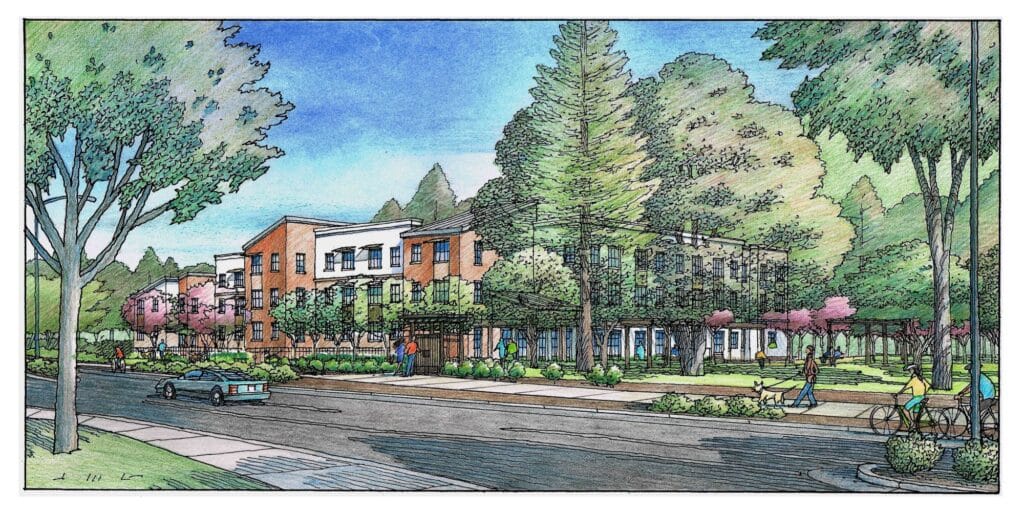“A No-Brainer:” Using Infill on VA Campus to House California Veterans

By Mark Fogarty
6 min read
Creative land development uses are always noteworthy. Consider Oak Gardens in Menlo Park, CA. This permanent supportive housing project for veterans has utilized the Congressionally authorized Enhanced Use Lease (EUL) program of the Department of Veterans Affairs (VA) to transform underused land on a VA property into a viable project.
Oak Gardens, developed by the nonprofit MidPen Housing, is being constructed on an infill site within the VA’s Palo Alto Health Care System campus. This development will provide veterans with easy access to VA services.

“It’s definitely a no-brainer,” says Abby Goldware Potluri, senior vice president and co-head of housing development for MidPen Housing, about the move to build veterans housing right next to a VA facility. “VA really understands the population and what the needs are. It was very targeted.”
Potluri notes that the housing is being built on an overflow parking lot at the facility. She says her company responded to a 2019 VA Request for Proposals. Since then, “it’s been a really great experience partnering with VA,” both with local VA officials and those in Washington, DC, dedicated to developing these sites.
“They have a lot of internal experience doing these in other places around the country,” she says. “Over the next couple of years, we worked closely with them on design and amenities,” plus the operating subsidies and subsidies for tenants.
“To have it all co-located is really exciting to us,” she says.
The project will contain 62 units, two of which will house on-site managers. The remaining 60 units will be set aside to house homeless veterans.
Thirty-five of Oak Gardens’ units will utilize project-based vouchers under the HUD-VASH program, a collaborative effort between the Department of Housing and Urban Development and the VA to provide housing and supportive services for homeless veterans.
The HUD-VASH project vouchers “are a great thing,” Potluri feels, “as they help support long-term operating expenses,” as well as subsidizing rents for tenants and providing case management. “Some residents will not have been inside their own home for years,” she says.
Subsidies Provide Deep Support
Only a few units are not subsidized through project- or tenant-based vouchers.
Asked if they would have trouble filling the HUD-VASH tenants, Potluri says, “I don’t think so,” even though the veteran homelessness problem in the area is less acute than it was a number of years ago. “It’s a very expensive market,” she says. “Even if you have generous benefits from the government and other assistance, it’s hard to find housing in Menlo Park for less than $3,500 to $4,000 a month.”
The lease-up process is expected to start “fairly soon” and take about three months.
Oak Gardens broke ground in November 2024, with construction expected to finish in February 2026. It utilized nine percent Low Income Housing Tax Credits, generating $27.6 million in equity. The investor is National Equity Fund.
The Housing Trust Fund of Silicon Valley has a $2.2 million permanent mortgage, funded by Apple, which funds housing in the Bay Area. The state’s Veterans Housing and Homeless Prevention program provided $12.8 million, San Mateo County contributed $4 million from its affordable housing fund, and the city of Menlo Park contributed another $2 million.
First Citizens Bank and the Federal Home Loan Bank of San Francisco are also funders.
The total development cost for the 62 units in the extremely expensive Bay Area is $50 million, even with a land lease of just $1 a year on the federally owned land.
In terms of design, a desk clerk will be at the entrance to Oak Gardens to provide a friendly face. Many of the amenities focus on healing from trauma, such as community gardens and calming outdoor spaces. Potluri points out that attention was also paid to acoustics and lighting to avoid triggering tenants.
“It’s a lovely place in the Bay Area,” she says. “There is great natural light.”
According to architect Van Meter Williams Pollack (VMWP), the site is near services, shops, grocery stores, restaurants, job opportunities, and public schools. Guzman Construction Group is the contractor.
“The building nestles among large existing heritage trees, with multiple gardens designed around the building to offer a variety of outdoor community spaces. On the ground floor, a double-height lobby welcomes residents and visitors. Community serving spaces, like a large community room and kitchen, VA services for case management meetings, and MidPen resident services/activities also provide a wide range of support for incoming residents,” says VMWP.
| Design Features * Historic Spanish style architecture of the original Menlo Park VA hospital building; * Simple sheds provide some visual interest; * Strong indoor-outdoor integration of building and landscape elements; and * Primary outdoor areas are adjacent to the community spaces. | Green Features * LEED Silver certification; * Large array of photovoltaic panels; * All-electric building: electric heating and cooling for residences and common areas, and centralized electric domestic hot water; * Saved mature oak and redwood trees; and * A dog run and walking path. |
The 2.14-acre site will have a 95 percent parking spaces-to-tenants ratio. Most units will be one bedroom, at an average of around 568 square feet, and all units will come with a full kitchen and bath. Rents will range between $950 and $1,647. Residents will be very low-income, between 30 and 50 percent of area median income.
MidPen Housing says, “Residents will enjoy amenities, such as a multi-purpose community room with a kitchen, a secure bicycle room, elevators, and laundry facilities. MidPen Services will offer case management and a broad array of on-site resident services that support education, physical and mental health, and economic mobility.”
The HUD-VASH Program
The HUD-VASH (Veterans Administration Supportive Housing) program is an uncommon example of a joint effort between two federal bureaucracies: the Department of Housing and Urban Development (HUD) and the Department of Veterans Affairs (VA).
These two departments team up to assist veterans who are homeless or in danger of becoming homeless. HUD provides rental housing through vouchers, while the VA is in charge of case management and the medical and social services it provides to veterans.
According to HUD, the program has been administered through Public Housing Authorities since 2008 (Indian Housing Authorities were added later). Each PHA must team with a VA facility. In the case of Oak Gardens, the PHA is the San Mateo County Housing Authority.
According to HUD, at least one PHA is currently administering HUD-VASH in each of the 50 states, the District of Columbia, Puerto Rico, and Guam.
As an example of the program’s impact, the Housing Authority of the County of Los Angeles awarded 3,442 vouchers through HUD VASH between 2008 and 2023, and the Housing Authority of the City of Los Angeles has awarded another 4,865.